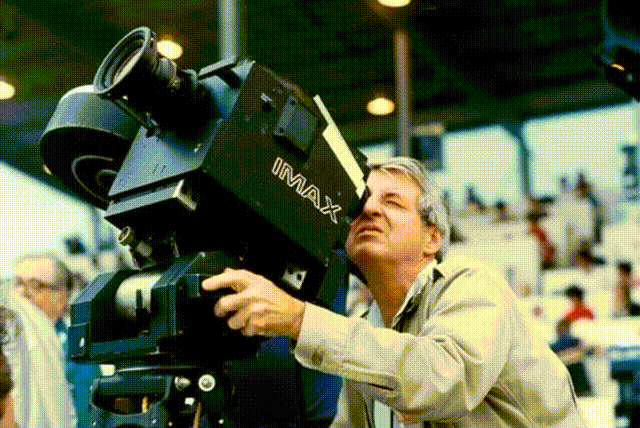IMAX Founders
The small-town visionaries who made cinema bigger than life itself

“
We said, ‘Let’s invent this new medium.’
Before IMAX, cinema was trapped behind the fourth wall—audiences watched stories unfold from a comfortable distance. But four Canadians from small-town Ontario had a different vision: what if the screen could disappear entirely, immersing viewers so completely they felt like participants rather than observers?
The story begins in 1940s Galt, Ontario, where three teenagers at the local collegiate—Graeme Ferguson, Robert Kerr, and William Shaw—bonded over their shared fascination with mechanics and storytelling. Their first collaboration was humble: a school newspaper that let them experiment with different ways of reaching audiences. None of them knew they were rehearsing for a revolution that would reshape global entertainment.
Ferguson, born to schoolteacher parents who emphasized education over entertainment, discovered his calling in 1950 during a summer internship at the National Film Board of Canada. There he met Roman Kroitor, a Ukrainian-Canadian philosopher-turned-filmmaker whose later work on the 1960 documentary "Universe" impressed Stanley Kubrick enough that the director tried recruiting him for "2001: A Space Odyssey."
The four men's paths converged at Expo 67 in Montreal, for which both Ferguson and Kroitor independently created groundbreaking multi-screen presentations. Ferguson's "Man and the Polar Regions" used 11 screens and projectors, while Kroitor's "In the Labyrinth" employed massive multi-screen technology for the National Film Board. Audiences were mesmerized—but the technology was clunky, expensive, and impractical.
"We realized people wanted to be surrounded by the experience," Ferguson later recalled. The challenge was engineering a solution that could deliver that immersion reliably, affordably, and beautifully.
In September 1967, they founded Multiscreen Corporation in Montreal, later renamed IMAX after the concept of "maximum image" was sketched on a restaurant placemat. Shaw, armed with engineering expertise from the University of Toronto and an MBA from McMaster, tackled the technical challenges. His breakthrough came in adapting an Australian patent for "rolling loop" film transport, creating a projection system that could handle 70mm film moving horizontally—ten times the image area of conventional cinema.

The innovation reflected distinctly Canadian problem-solving principles. Where Hollywood prioritized spectacle, the IMAX founders emphasized education and accessibility. Where American tech culture celebrated individual genius, they embodied collaborative innovation. Kerr, drawing on his experience as mayor of Galt, handled the business relationships that made their vision financially viable.
"There was never any question that we wanted to serve institutions—museums, science centers, places where people came to learn," Ferguson explained. Their first permanent installation opened at Toronto's Cinesphere in 1971, showcasing Canadian landscapes through "North of Superior," a film designed to capture the overwhelming scale of Northern Ontario wilderness.
The technology succeeded because it solved a fundamentally Canadian challenge: how do you convey the emotional impact of landscapes so vast they defy conventional representation? Canada's geography demanded innovation that could make audiences feel the true scale of wilderness, the spiritual connection to nature that defines Canadian identity.
Shaw's engineering philosophy reflected this collaborative approach: "The goal was never to show off technical prowess, but to disappear entirely so audiences could experience something impossible." His inventions—from the Rolling Loop projection system to IMAX Dome technology—prioritized reliability and precision over flashiness.
By the 1990s, IMAX had become a global phenomenon, with hundreds of theaters worldwide showcasing everything from nature documentaries to Hollywood blockbusters. The technology that began as four Canadians' experiment in immersive storytelling had created an entirely new category of premium entertainment.
The success embodied Canada's approach to innovation: patient, collaborative, focused on public benefit rather than pure profit. Where Silicon Valley celebrated disruption, the IMAX founders built bridges—between art and technology, education and entertainment, local vision and global impact.
Ferguson received numerous honors for his contributions to cinema, while Shaw was recognized as one of the most important inventors in motion pictures in decades. But perhaps their greatest achievement was proving that Canadian values—collaboration over competition, community service over individual achievement—could create world-changing innovation.
Today, as audiences worldwide experience everything from "Interstellar" to nature documentaries on screens that wrap around their peripheral vision, they're experiencing the legacy of four small-town Canadians who believed cinema could be bigger than entertainment—it could be transformation.
The IMAX story proves that sometimes the most revolutionary ideas come not from disrupting existing systems, but from asking a fundamentally different question: instead of how can we improve what exists, how can we create something that makes people feel truly present in the experience itself?

